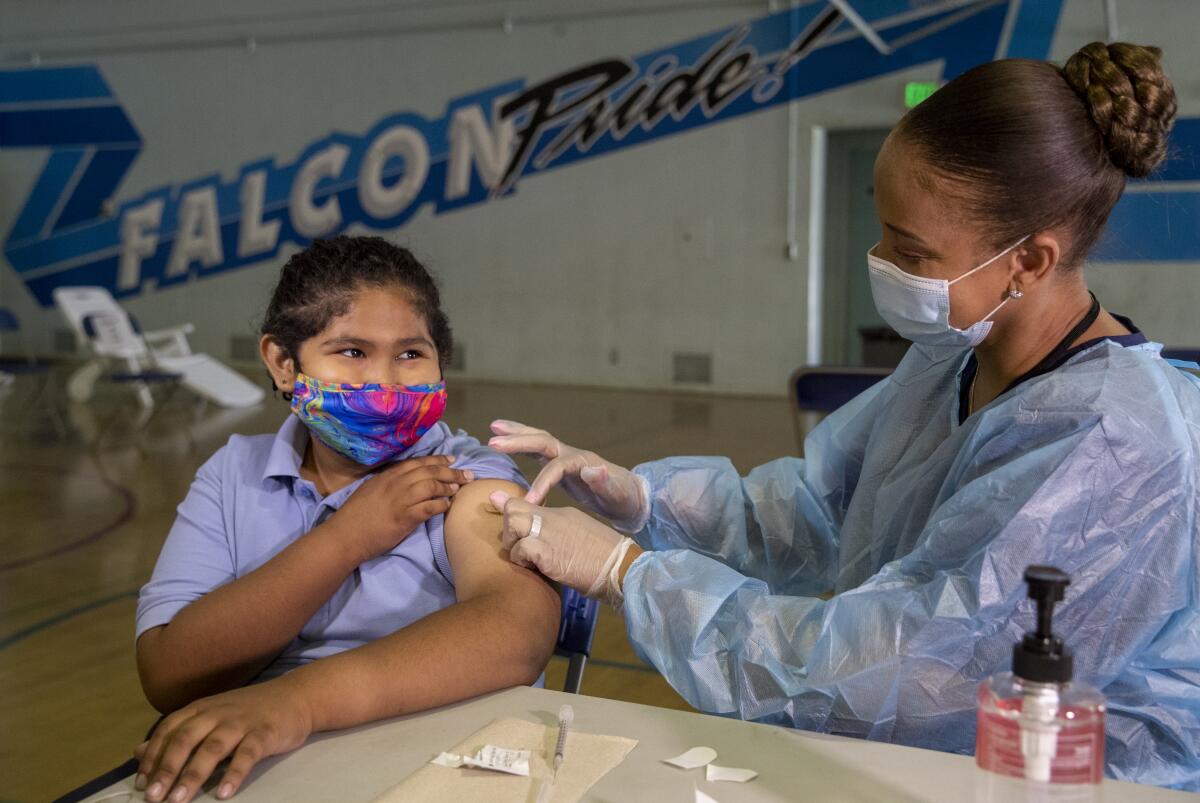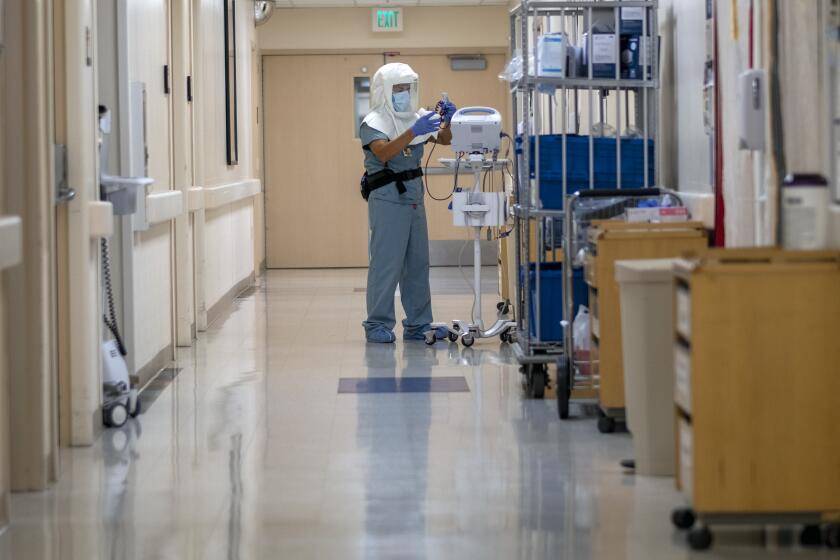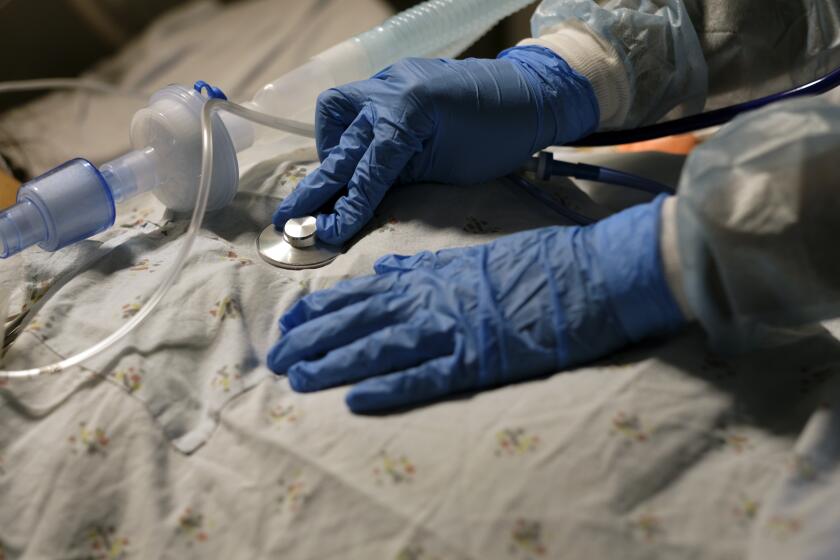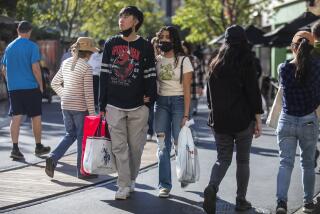Urban California taming virus surge, but areas with low vaccination rates still in danger

- Share via
Coronavirus cases are showing new signs of slowing across many parts of the state, led by improvements in Southern California and the San Francisco Bay Area, while other areas of rural Northern California and the Central Valley continue to struggle with much higher rates of hospitalizations, according to a Los Angeles Times data analysis.
Over the last month, new daily coronavirus cases in California have been generally stable, hovering between 12,000 and 15,000 a day, according to the analysis. And as of Monday, COVID-19 hospitalizations across California had fallen for six consecutive days — by 8% — from the summertime high recorded on Aug. 31.
But the improvements are not even. While hospitalizations for the disease caused by the coronavirus have flattened across the most populated areas of California, regions where vaccination rates are relatively low remain hard hit by the virus.
The Sacramento area recently reported hospitalizations nearly as bad as during the winter surge; in California’s rural north, COVID-19 hospitalizations are almost twice as severe as they were during the peak of the winter wave. Physicians in Mendocino County say: “Never before have we seen such a surge of sick, young patients.”
The number of kids being hospitalized with COVID-19 raced up the charts in midsummer, especially in places with low vaccination rates.
Kern County, home to Bakersfield, recorded a new COVID-19 hospitalization high for the summer on Thursday. In the San Joaquin Valley, available capacity in intensive care units has been below 10% for seven days, and state health officials have implemented COVID-19 hospital surge protocols there.
Hospitalization rates are still relatively high throughout California for those suffering from COVID-19. Some experts have suggested it’s reasonable to take emergency measures, such as enacting mask mandates, when there are 5 or more people hospitalized with COVID-19 for every 100,000 residents. The San Francisco Bay Area’s rate is 12 hospitalizations for every 100,000 people; Southern California’s is 17; Greater Sacramento is at 30; rural Northern California, 36; and the San Joaquin Valley, 38, according to The Times’ analysis.
Nonetheless, COVID-19 hospitalizations are no longer rising as sharply as they once were in most parts of California. And in the state’s two most highly populated regions, hospitalizations have been drifting downward for the last two weeks, falling 12% in Southern California and 17% in the San Francisco Bay Area.
Experts warn that it’s still plausible the pandemic could worsen following the Labor Day holiday, and said it was essential that more people get vaccinated.
Some officials have cautioned that the wide return of students and staff to school, as well as gatherings and travel over the long weekend, could provide fertile ground for more transmission if people didn’t take precautions to protect themselves.
“Our team here is prepared to see another increase in cases over the next few weeks as we have, again, large numbers of people intermingling in new settings,” Los Angeles County Public Health Director Barbara Ferrer said. “My hope is that it doesn’t turn into another large surge because we are, while slow, still getting more and more people vaccinated.”
Although improving, coronavirus transmission remains high, and the risk of infection is significant, especially among unvaccinated people, who are far more likely to be hospitalized or die than vaccinated people. Virtually all of California’s counties — as well as 95% of counties nationwide —are considered by the U.S. Centers for Disease Control and Prevention to have “high” or “substantial” coronavirus transmission rates, the two worst categories on the agency’s four-tier scale.
Overall, California is weathering its fourth pandemic wave far better than some places nationwide, likely thanks to its overall vaccination rate — one of the highest in the nation, with 82% of residents 12 and older having received at least one dose — and indoor mask mandates imposed by counties where most Californians live.
Among unvaccinated COVID-19 patients, infection with the Delta variant doubles the risk of needing hospital treatment, a study finds.
At its worst moment this summer, California’s coronavirus case rate was roughly one-third of its winter peak, but Florida has been reporting case rates worse than at any prior point in the pandemic.
As of Tuesday night, according to the CDC, California had the fifth-lowest weekly coronavirus case rate in the nation, with 124 weekly cases per 100,000 residents; West Virginia, with a rate of 594, had the worst. The nation’s second-most-populous state, Texas, had a rate of 437, and Florida, the third most populous, was at 533.
A weekly rate of 100 or more new coronavirus cases for every 100,000 residents is considered to be “high.”
Additionally, pediatric hospitalization rates have not climbed to record highs in California this summer, as is the case nationally and in Texas and Florida. Florida has a daily rate of new pediatric COVID-19 hospitalization more than six times that of California, while Texas’ is more than four times worse than California’s.
Promisingly, there has not been an alarming surge of coronavirus transmission in schools in Los Angeles and Orange counties, suggesting that measures including mask mandates in school settings have the potential to keep coronavirus transmission rates relatively well-controlled.
“Indoor masking is key in areas of high transmission,” tweeted Dr. Ashish Jha, dean of the Brown University School of Public Health.
One recent study cited by the CDC director, Dr. Rochelle Walensky, found that the rate of hospitalization for children was nearly four times higher in states with the lowest overall vaccination coverage when compared to states with high overall vaccinations.
The number of kids being hospitalized with COVID-19 raced up the charts in midsummer, especially in places with low vaccination rates.
Even if this is now a turning point for California, it will take some time for the pressure on hospitals to ease.
Although the state’s weekly coronavirus case counts are no longer spiking to the extent seen earlier in the wave, they’ve also yet to drop in a sustained or significant way.
And severely ill COVID-19 patients “are still causing a degree of stress on our hospitals, given the high number of non-COVID patients,” said Dr. Christina Ghaly, the L.A. County director of health services. “Nurse staffing is extremely limited at this time.”
Hospitals remain strained, “but they are less strained now, I believe, than they may have been two or three weeks ago on balance,” said Dr. Matt Zahn, a deputy health officer for Orange County.
Health officials are leery about suggesting that the reduction in disease will be sustained in California given factors such as the reopening of schools, with more children and staff returning to classrooms than at any time since the pandemic began about 18 months ago.
The biggest variable is the widespread Delta variant, which is the most transmissible version of the coronavirus yet and accounts for virtually all cases statewide, genomic sequencing data show.
During the previous surge, coronavirus cases rose sharply starting around mid-October. But when they began to fall from the early February peak, they did so dramatically. It’s unclear whether this current wave will follow a similar pattern.
“We’ve seen this before, that viruses can also oftentimes go ahead and peak dramatically and then dramatically decline,” Ferrer said. “And it’s unclear to us with the Delta variant if that might be part of what’s contributing to what looks like a small decline at this point but could become a larger decline.”
She added, “We’re not making any predictions in this go-round because there are some things that are still creating additional risk for us.”
It’s also possible that a more optimistic scenario will present itself and that, once case rates fall, they will stay down, according to Dr. Monica Gandhi, a UC San Francisco infectious diseases expert. But only time will tell.
Santa Clara County, Northern California’s most populous county, shows what can happen in an area with high vaccination rates. The county — home to Silicon Valley — has reported that 88% of residents 12 and older have received at least one dose of vaccine; in L.A. County, 75% of residents in the same age group have received at least one dose.
Yet COVID-19 deaths in Santa Clara County in the summer have not increased as much as expected given the increase in cases, said Dr. Sara Cody, the Santa Clara County public health director and health officer.
Santa Clara County has reported 30 COVID-19 deaths this summer, according to its website, a rate of 1.6 deaths for every 100,000 residents. Los Angeles County, by contrast, reported 1,026 deaths over the summer, a rate of 10.2 deaths for every 100,000 residents.
“I think that this can be attributed to the protective effects of ... the vaccinations in the population at large,” Cody said in a public meeting last week. “So far, our deaths really have been blunted, I think, from the very high vaccination rates.”
Still, no one can be confident about what the future holds, and Gandhi suggested that other local governments in California pursue mandatory requirements for customers of indoor restaurants, bars and gyms to show proof of vaccination to enter, something San Francisco and Berkeley have done.
“In this interim period to get vaccination rates up, I think vaccine passports are a very good idea,” Gandhi said. “I don’t think anyone doubts that vaccines are more effective than masks.”
More to Read
Sign up for Essential California
The most important California stories and recommendations in your inbox every morning.
You may occasionally receive promotional content from the Los Angeles Times.














